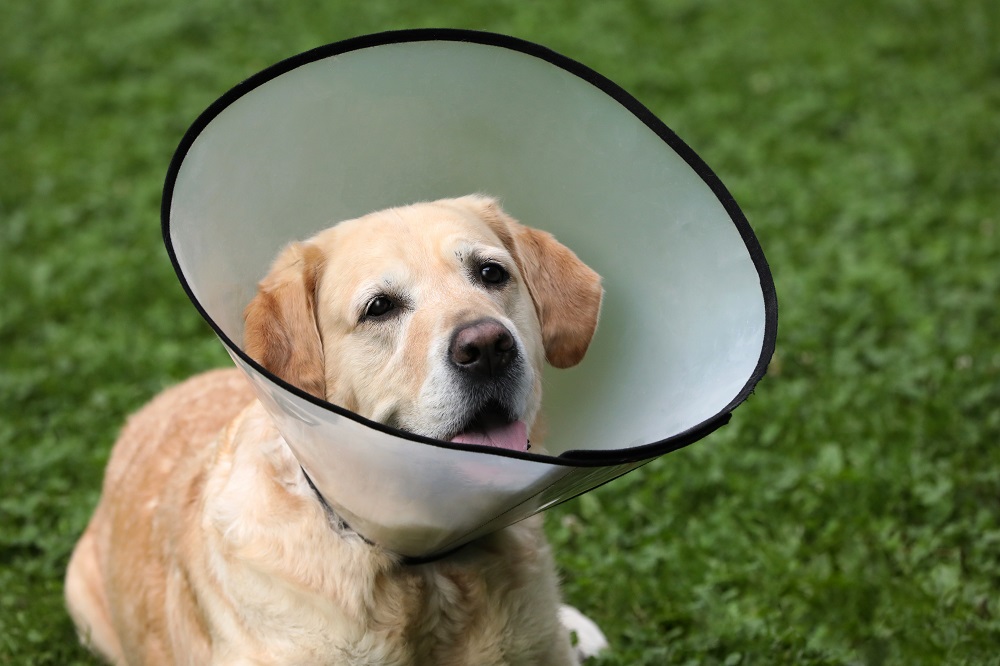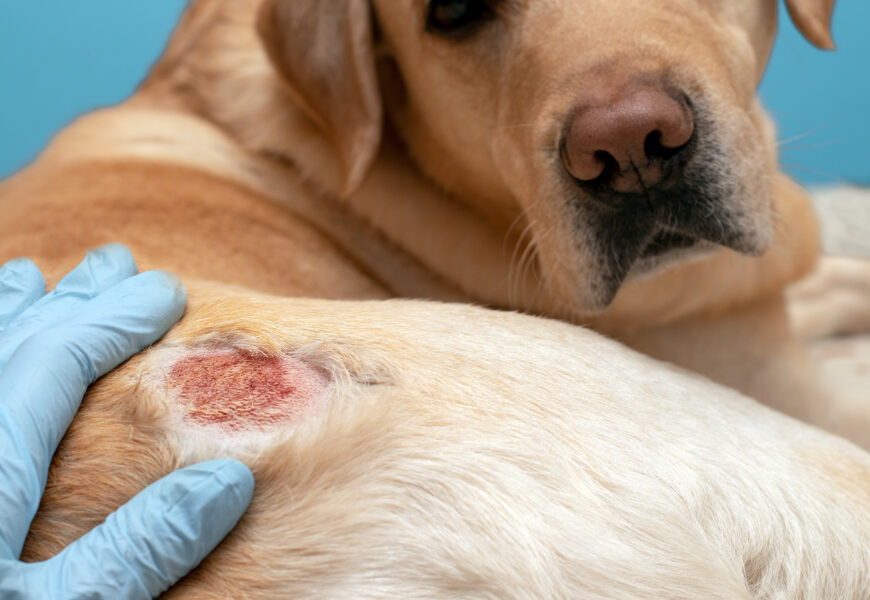by Dr. Primrose Moss
Excessive itching, oozing discharge, and pain: Anyone whose dog has had a severe hot spot knows that these skin infections can have a huge impact on your Lab. Also known as pyotraumatic or acute moist dermatitis, this condition can progress rapidly and cause severe distress if it’s not treated quickly.
What is a hot spot?
This colloquial term is used to refer to localized skin infections affecting the most superficial layers of the skin. These are most commonly caused by bacteria such as Staphylococcus aureus, which is found on the skin of healthy dogs but overgrows and causes disease when given the opportunity. Despite their superficial nature, these bacteria can still cause severe problems. Once they’ve successfully established an infection, they spread and worsen rapidly, often visibly progressing in less than 24 hours.
What causes hot spots?
Hot spots are most common in thick-coated dogs, including Labradors. Anything that disrupts the skin barrier can allow the bacteria on the skin to overgrow and cause an infection. Common causes include allergies, mites, fleas, poor grooming, and excessive skin humidity; all of these factors can compromise the skin barrier and result in self-trauma due to itching, allowing bacterial infection to take hold. It can sometimes be difficult to identify the underlying cause of a hot spot, but most of them resolve regardless with appropriate treatment. However, if your Lab has recurrent hot spots or other symptoms, it’s worth investigating further.
How are hot spots diagnosed?
Hot spots have a characteristic appearance, and diagnosis is often based on this alone. If you’ve seen one hot spot, you’ll almost certainly recognize another.
Hot spots typically begin as a small, reddened area of skin. This very rapidly develops into a more substantial focal area that’s red, inflamed, and oozing discharge. The hair may be rubbed off the area or form a dense, crusted scab of dried discharge over the surface of the skin. There’s often a significant amount of discharge present. You’ll also notice that the area is itchy and painful – your Lab may be trying to scratch or lick at it or become distressed if you attempt to touch it.
As the infection progresses, bacteria may infiltrate slightly deeper into the skin and cause inflammation of the hair follicles. At this stage, raised bumps may be seen as the infection spreads into the surrounding skin.
While it’s often reported that hot spots are most common on the head, neck, legs, and hips, they can occur almost anywhere on a dog’s body. They usually start off small but can affect a large area of skin in just a few days.
If your Lab has any other symptoms or the appearance of the lesion is not completely typical, your vet may recommend further testing to rule out other conditions like mites. This often requires a skin scrape, which provides a sample that can be assessed under the microscope to look for bacteria, mites, or even fungi.
Treating hot spots
The first step in treating any hot spot is to seek advice from your veterinarian. These infections rarely resolve on their own and can progress rapidly, causing severe pain to your Lab.
Your vet will usually clip the hair over the affected area to prevent further matting and allow it to be cleaned. Typically, they will then bathe the area with dilute chlorhexidine disinfectant; if you have this available at home, you can try to bathe the area while you wait for a vet appointment. However, if you’re not certain it’s a hot spot or your Lab has other symptoms, this could interfere with your vet carrying out diagnostic tests. In very severe cases, a brief sedation may be necessary for your vet to clip and clean the area as hot spots can be intensely painful.
Depending on the severity of the infection, your vet may then recommend either topical or oral treatments. These usually include an antibiotic and a steroid, the former to treat the infection and the latter to control the itching and inflammation. For topical use, these are often combined into a single product. Severe cases are more likely to need oral medication; however, oral treatments typically come with more side effects, like disrupting the gut microbiome, so they should only be used when necessary.
For dogs with an underlying condition, your vet may recommend additional treatments such as parasite treatments or allergy medication.

In the majority of cases, dogs also require an Elizabethan collar, or plastic cone, to prevent further licking and scratching. Even with medication, continued trauma to the area can allow infection to persist or reestablish.
If your Lab will tolerate it, your vet may also recommend bathing the affected area daily, usually with dilute chlorhexidine disinfectant or specific wipes. But be careful: Even sweet-natured dogs may become reactive if they’re especially sore. Medication should be the priority rather than bathing in these cases.
Most dogs respond rapidly to treatment, with many hot spots resolving in under a week. However, some skin infections can persist a little longer, so it’s important to attend follow-up appointments if needed. Rarely, antibiotics can be required for several weeks for full resolution of skin infections. If the infection doesn’t respond well to treatment, further testing may be needed – for example, a swab for culture and sensitivity to identify an appropriate antibiotic.
Preventing hot spots
As the saying goes, prevention is better than cure. Hot spots are painful and frustrating to deal with, and nobody wants extra vet visits! There are a few things you can do to try to prevent hot spots:
- Keep up to date with parasite treatments, especially if your Lab is sensitive to fleas.
- Monitor your dog for signs of allergies. If your Lab does suffer from allergies, managing them effectively can significantly reduce his chances of subsequent infections.
- Maintain your dog’s coat. Regular grooming (at home or the groomer) helps to keep the skin healthy.
- Dry your dog thoroughly after swimming or bathing.
- Add in mental stimulation to distract your Lab from licking. If your Lab licks excessively, ask your vet about possible underlying causes like pain. If it’s a purely behavioral issue, try providing some extra mental stimulation, like slow feeders, puzzle games, and training.
- Consider your bathing products. Use dog-safe products to avoid irritation and consider soothing oatmeal-based shampoo if your Lab is prone to itchiness.
What can you do before seeing the vet?
If you suspect a hot spot, it’s important to book a vet appointment sooner rather than later.
Before attending the vet, using an Elizabethan collar to prevent licking or scratching can help; however, your Lab will still be frustrated by the itching, so it’s best to see a vet as soon as possible. If your Lab will tolerate it – and you’re certain it’s a hot spot and not a wound or other condition – you may also try bathing the area with dilute chlorhexidine disinfectant once or twice daily. However, this is very unlikely to resolve the hot spot by itself and may contribute to skin irritation and dryness if used repeatedly.
Avoid using leftover antibiotics from previous conditions as this could contribute to a resistant infection and cause more problems down the line.
Hot spots are an unpleasant condition to deal with, but the good news is that they usually respond rapidly to treatment. If you suspect a hot spot, early treatment is vital for a quick recovery and minimal pain and discomfort. If your Lab gets recurrent hot spots, it’s worth identifying any underlying factors that might be contributing – whether it’s his love of swimming or an ongoing allergy – and managing them appropriately.
Dr. Moss is a small animal veterinarian based in the UK. Having qualified from the University of Cambridge with her Bachelor of Veterinary Medicine and a Master’s in Zoology, she enjoys all aspects of her work but has a particular passion for client communication and education. Through her writing, she aims to make accurate and reliable veterinary advice accessible to pet owners around the world.




